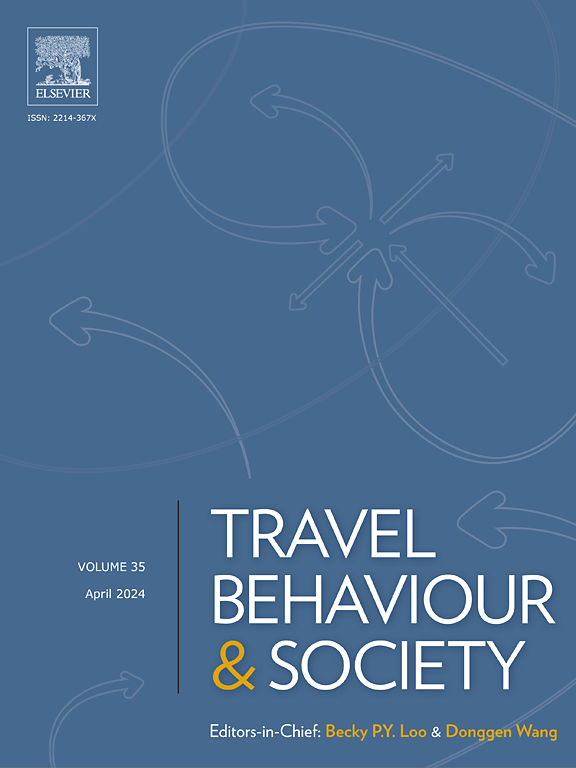揭示微观层面视觉特征对芝加哥城市拥堵的影响
IF 5.7
2区 工程技术
Q1 TRANSPORTATION
引用次数: 0
摘要
城市交通拥堵仍然是当代城市面临的一个持续挑战,大多数现有研究都侧重于宏观尺度的建筑环境特征,如土地利用和交通网络,而忽视了嵌入在微观尺度街景中的视觉和感知线索,这些线索会影响实时驾驶行为。为了解决这一差距,本研究调查了从谷歌街景图像中捕获的街道视觉特征与美国芝加哥路段尺度的交通拥堵之间的关系。利用语义分割和地理加权回归,我们提取了7个关键视觉特征,并研究了它们与交通拥堵强度的空间变化关系。我们进一步提出了一个双路径解释框架,区分物理功能路径(其中视觉特征充当交通产生的土地使用和街道功能的代理)和感知行为路径(其中视觉复杂性和自然元素塑造驾驶员的认知和行为)。我们的研究结果表明,与仅使用宏观层面变量的模型相比,结合视觉特征显著提高了模型的性能,解释力提高了约19%。建筑和车辆等视觉元素被发现与高需求走廊的拥堵呈正相关,而天空能见度、树木和人行道等特征则表现出缓解拥堵的效果——不是普遍的,但在特定的视觉和功能环境中,正如司机所经历的那样。重要的是,这些影响在空间上是异质的,反映了当地土地利用模式、街道等级和感知环境的变化,从驾驶员的角度来看。这项研究强调了将视觉感知属性整合到城市交通分析中的价值,并呼吁考虑街景结构和认知维度的环境敏感交通规划。本文章由计算机程序翻译,如有差异,请以英文原文为准。
Unveiling the impact of micro-level visual features on urban congestion in Chicago
Urban traffic congestion remains a persistent challenge in contemporary cities, with most existing research focusing on macro-scale built environment features such as land use and transport network and overlooking the visual and perceptual cues embedded in micro-scale streetscapes that influence real-time driving behavior. To address this gap, this study investigates the relationship between street-level visual features—captured from Google Street View imagery—and traffic congestion at the road segment scale in Chicago, U.S.A. Leveraging semantic segmentation and geographically weighted regression, we extract seven key visual features and examine their spatially varying associations with congestion intensity. We further propose a dual-pathway interpretive framework, distinguishing a physical-functional path (where visual features act as proxies for traffic-generating land use and street function) and a perceptual-behavioral path (where visual complexity and natural elements shape driver cognition and behavior). Our findings demonstrate that incorporating visual features significantly improves model performance, increasing the explanatory power by approximately 19 % compared to models using only macro-level variables. Visual elements such as buildings and vehicles are found positively associated with congestion in high-demand corridors, while features like sky visibility, trees, and sidewalks exhibit congestion—mitigating effects—not universally, but in specific visual and functional contexts as experienced by drivers. Importantly, these effects are spatially heterogeneous, reflecting variations in local land use patterns, street hierarchy, and perceptual environments, as captured from a driver’s viewpoint. This study highlights the value of integrating visual-perceptual attributes into urban mobility analysis and calls for context-sensitive transport planning that considers both structural and cognitive dimensions of the streetscape.
求助全文
通过发布文献求助,成功后即可免费获取论文全文。
去求助
来源期刊

Travel Behaviour and Society
TRANSPORTATION-
CiteScore
9.80
自引率
7.70%
发文量
109
期刊介绍:
Travel Behaviour and Society is an interdisciplinary journal publishing high-quality original papers which report leading edge research in theories, methodologies and applications concerning transportation issues and challenges which involve the social and spatial dimensions. In particular, it provides a discussion forum for major research in travel behaviour, transportation infrastructure, transportation and environmental issues, mobility and social sustainability, transportation geographic information systems (TGIS), transportation and quality of life, transportation data collection and analysis, etc.
 求助内容:
求助内容: 应助结果提醒方式:
应助结果提醒方式:


